
Heckler & Koch P7M13 - MGC
Another intriguing airsoft gun and another 'classic'.
The H&K P7 is an interesting gun in real steel form with a grip cocking action and the MGC P7 (even more than their Glocks) is often held up as the 'best ever GBBs'.
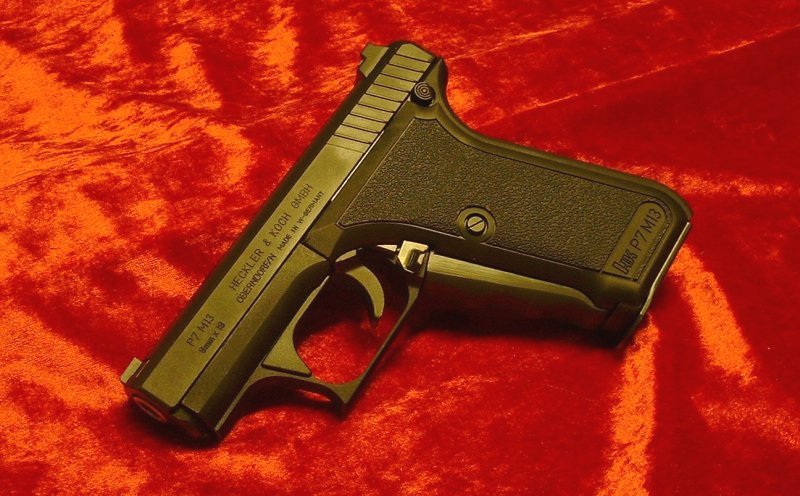
I was keen to try one, just to see if the claim had any validity or was just Classic enthusiasm. I narrowly missed one at a reasonable price and then a few weeks later 3 more appeared at more sensible prices than are often the case.
I snapped up the nicest of the 3 (according to the previous owner) and it was soon in my hands.
In the Box
The box itself is quite probably worthy of the title 'best ever GBB box' and, even before you open it up, bodes well for the contents.

The box, looking like a replica of an 80s real steel box, is constructed of black plastic and bears HK logos on the right side of the lid with P7 M13 beneath it. On the left side of the lid are the words "HECKLER & KOCH GMBH"/"OBERNDORF/NECKAR"/Fed. Rep. of Germany" with "AIRSOFT GUN" and some Japanese script advising use by over 18s only (the 18 is visible as digits).
The "HECKLER & KOCH GMBH"/"OBERNDORF/NECKAR"/Fed. Rep. of Germany" text is repeated in depressed panels on each side of the box. If Oberndorf Am Neckar rings a bell you cannot place, check this review, which, no doubt, provides a clue to H&K's history.
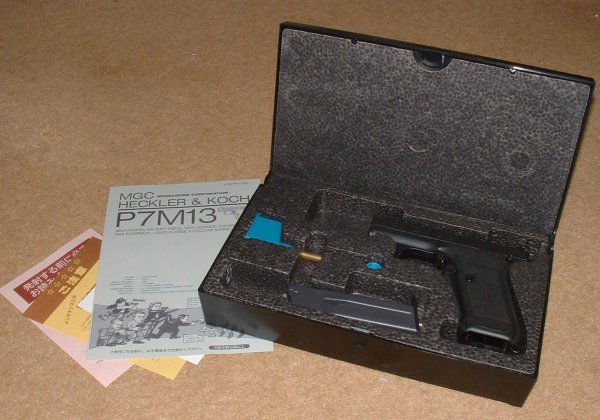
Inside, the P7 nestles in a dense polystyrene bed, very similar to recent KSC boxes and there is another panel of this material (all grey) to cover the gun. The bed itself is cut-out for the gun (with optional compensator, not fitted to this model) and the various accessories.
As well as the P7 itself, there is a tube, hopper and rod loader and a manual.
First Impressions
Taking the P7 from the box, I was struck by three things.
Firstly, the P7 feels cold, as if it was made of steel. Other guns use a metal and ABS mix, but I cannot think of one which is feels so convincing. Even metal airsoft guns I've handled (which use aluminium or zinc) have not feel as good.
Secondly, the grip is a most peculiar feeling thing. It makes the, otherwise compact, P7 seem bulky and cumbersome, notably in the front to rear dimensions.
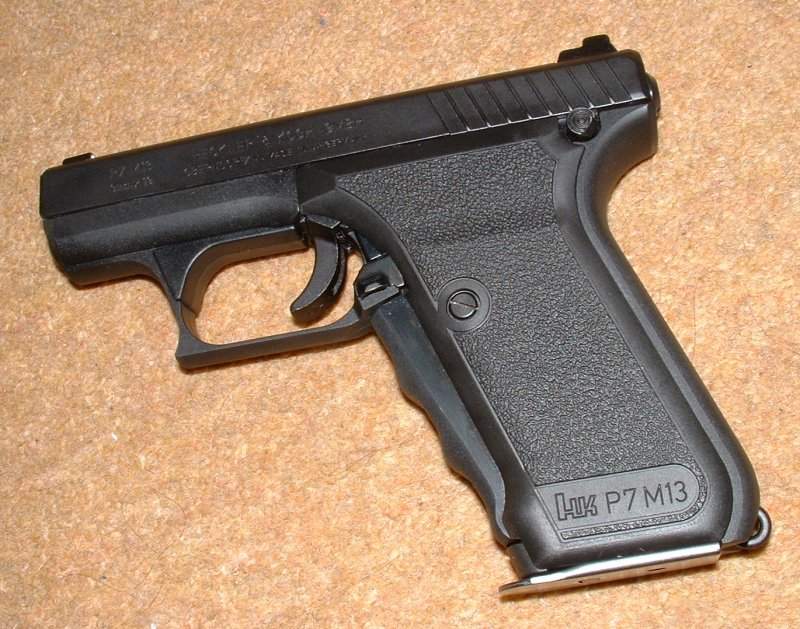
Finally, the finish really is remarkably good. The gun is small, but heavier than many full size guns, and the quality of the materials used is instantly apparent. It is hard to believe that the same person masterminded this gun and the disappointing Tanio Koba H&K VP70M.

The slide and frame are made of the heavyweight material and the grip panels, too, are very heavy in themselves. The grip cocker is all metal as are the ambi mag release, the trigger and the front and rear sights.
Markings, too, look convincing and are well rendered, sharp, well proportioned and convincingly deep.
Closer Look
The P7 that MGC chose to replicate is the 9mm, double stacker M13. This was developed from the earlier PSP, which was developed as a weapon for the German Polizei in the aftermath of the Munich Olympic catastrophe. There is (As the P7 is still listed by Heckler & Koch as a production item) also the single stack M8 (this holds 8 rounds versus 13 of the M13).
The significance of this is that the MGC P7 is quite a broad gun, with a big grip and an oddly low and short slide.
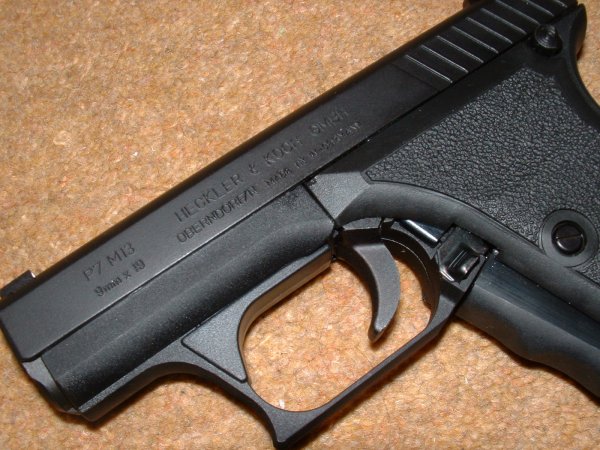
To my eyes, it is far from an attractive design, but that cannot be held against MGC.
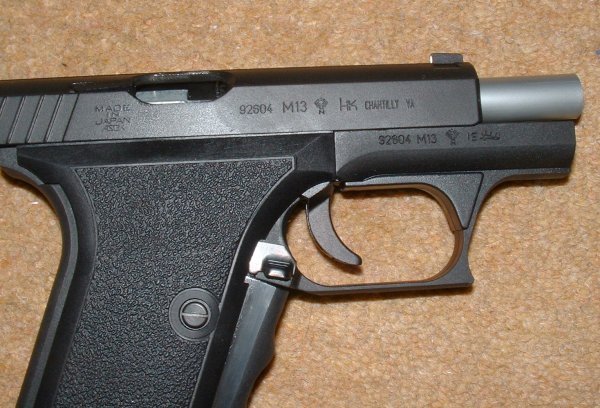
As observed before, the gun is very solid feeling. The design differs from most other H&K guns in that the frame of the P7 is metal (ABS/metal mix here of course) and has detachable grips which are of a very similar material to the USP and Mk23 frames.
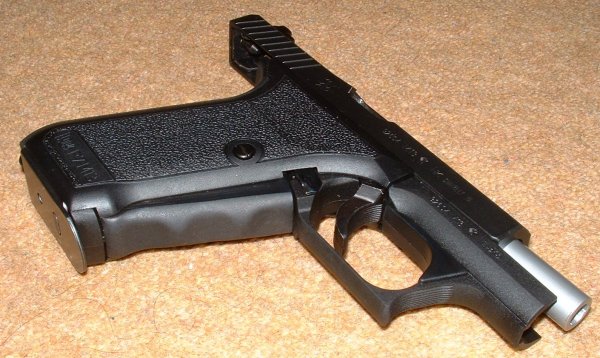
The broad trigger and cocking grip are both made of metal and feel solid. The trigger has a number of raise ridges to aid grip, but the grip cocker is smooth, albeit with slight finger depressions.
Picking the gun up, you need to give the cocking grip a firm squeeze to cock it, but a fairly gentle pressure keeps it active. Releasing the grip completely will require the grip to be fully squeezed again to re-cock it. The point of this was to make the P7 very fast to transition from totally inert to ready to fire and many experts believe it perfectly achieves this.

The magazine release, in the form of a small lever either side of the trigger, by contrast, feels fragile and flimsy, although it is also metal. Certainly the release on USPs and Mk23s feels much more substantial and are easier to find quickly.
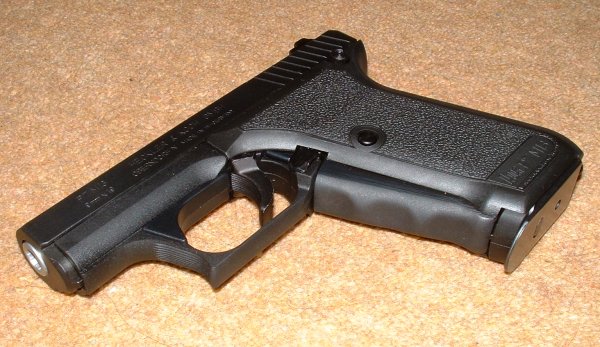
The slide moves back and forth with a reassuring solid kick, but the chamber (as on the JAC Browning Hi-Powers
is not fully open, only revealing the old fashioned blowback unit inside. The magazine, too, is quite flimsy compared to a modern GBB's, but seems to be
absent of any leaks, despite its age.
In terms of markings, the MGC P7M13 is, undoubtedly, one of the best airsoft guns ever made.
Aside from the "MADE IN JAPAN"/"ASGK" marking on the right side of the slide, just behind the ejection port, the markings look to be just about
100% accurate. As well as those markings, the right side of the slide is marked 92604 (a serial number), M13 followed by a proof mark, a small HK logo and the words
"CHANTILLY VA" (Heckler's operation in the US). The serial number, M13 and proof mark are repeated on the frame.
On the left side, the slide is marked "HECKLER &KOCH GMBH"/"OBERNDORF/N" and "MADE IN GERMANY" in a smaller lettering. Towards the muzzle, the slide
is also marked "P7 M13"/"9m x 19".
Both sides of the grip panels are marked with the H&K logo and P7M13.
Actually operating the P7 is interesting. It was designed, as mentioned earlier, to be ultra safe, but be very quick to transition to the
point where it can be fired. The simple operation of squeezing the grip cocks the gun and allows you to pull the trigger.
There is no hop-up on the MGC P7. Instead it features a 'cyclone' rifled barrel, but these seem to have been more a gimmick than particularly
useful at extending range.
Carrying out my standard 5m/6 round, off hand test, however, the P7's age started to show. .25g BBs fell well below the aimpoint and
I shifted my aim to the head (marked above).
The .25g BBs fell in a pretty inconsistent spread with a best 5 grouping of 2.25 inches or 5.5 CM (marked as squares above) and I wondered if, perhaps I was being unfair to the gun, so switched to the .2g Excels
I usually use for fps testing.
The lighter BBs still fell below the aimpoint, albeit less far, but they grouped worse, the best 5 grouping being a dreadful 13CM (5 inches)
across, marked as circles above.
Over 10 shots, the MGC P7M13 averaged just 190 fps (using Abbey Ultra gas) indoors (at an admittedly cool 14C). This is on a par with the JAC
Browning, but disappoints by modern standards. As a comparison, a KWA Glock 18C tested at the same time averaged 267 fps.
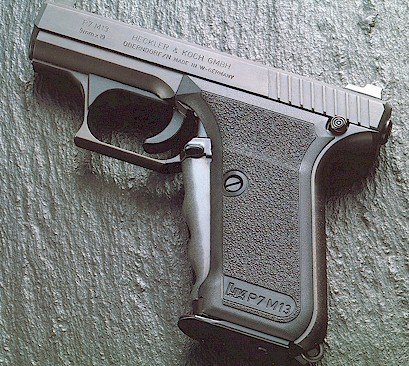
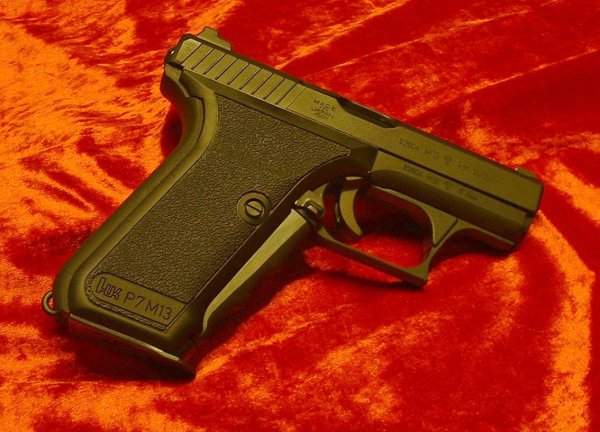
Shooting Impressions
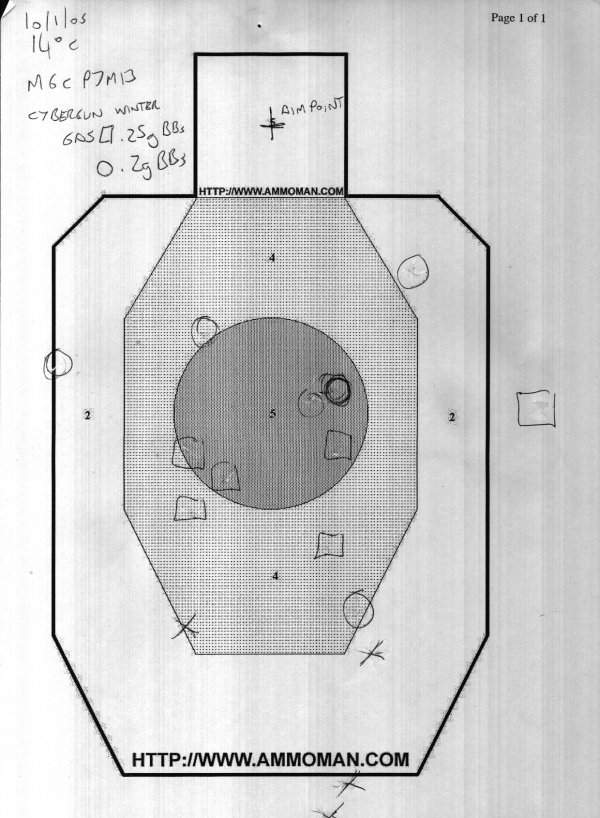
Click on image for bigger version in separate window.
| Shot | FPS |
| 1 | 213.8 |
| 2 | 196.0 |
| 3 | 193.7 |
| 4 | 188.2 |
| 5 | 187.5 |
| 6 | 177.9 |
| 7 | 177.4 |
| 8 | 191.0 |
| 9 | 190.6 |
| 10 | 185.6 |
In case you think my gun is old and worn, this Japanese site reports similar performance (once adjusted for temperature).
Once cocked, the trigger pull appeared heavy for a GBB at around 88 oz (2,500 g), although I wonder whether there is something about the P7's action that defeats my rather primitive pull weight tester as it does not feel that heavy in use. It's no lightweight, but in use, it does not feel obstructive.
Take Down
Take down is, as is often the case with classics, not identical to the real thing.
On the real P7, you press in a button near the rear of the gun (on the left slide) and simply lift the rear of the slide and push it off of the frame.
With the MGC P7, you first have to unscrew the screw securing the rear sight. With this out (and the magazine out) you can lift the rear of the slide slightly and push it off of the frame.
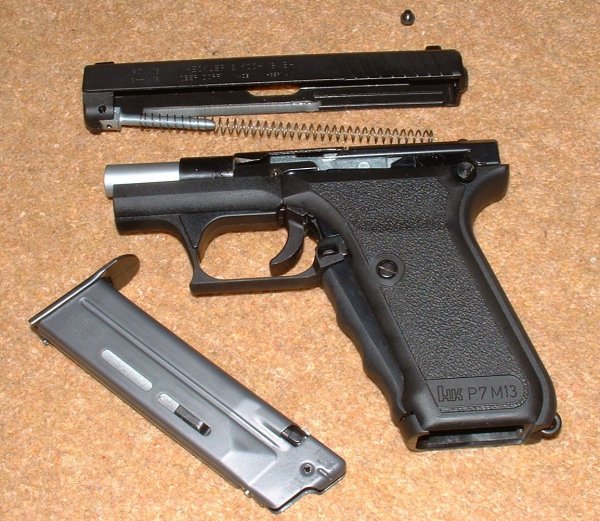
The barrel (as with the VP70) stays attached to the frame, as in the case of the real gun.
Conclusions
So, is this the best GBB ever made?
I could cop out and say it is impossible to compare this older design with modern GBBs, but you are all wanting, at least, my opinion, now.
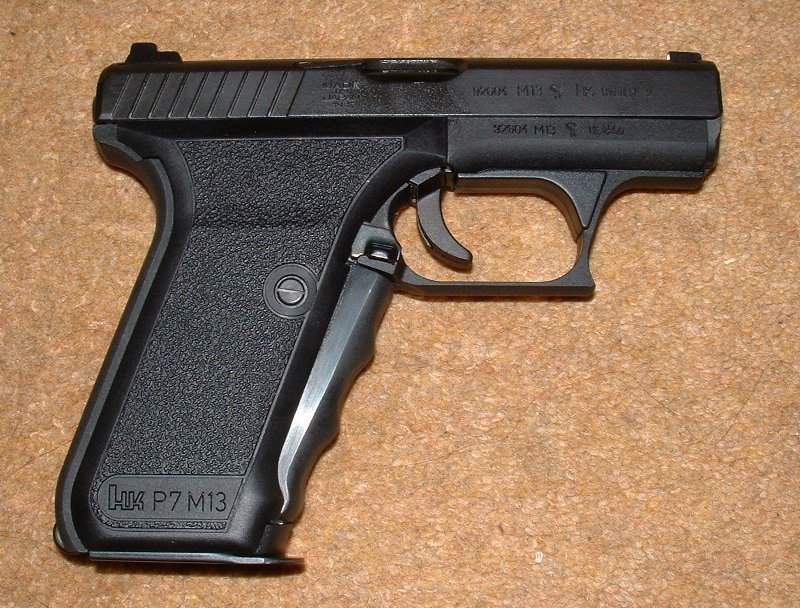
In terms of finish, realism and overall quality of the package, I would say I have not seen any airsoft gun which is better.
In terms of performance, however, the MGC P7M13, like the JAC Browning Hi Power, has been left far behind by modern GBBs.
So, although a beautifully made GBB, it cannot lay claim to being the best, overall, that I have seen.
There is, though, no denying it is a fine gun for any collector to own and remains a great example of what can be done in terms of making airsoft pistols look and feel realistic, which is approached by few modern GBBs.
Weight : 850g
Realism : ****
Quality : *****
Power : **
Accuracy : ***
Real Steel link at World Guns
An unofficial P7 website
MGC H&K P7 review at Arnie's Airsoft
Back to the Homepage